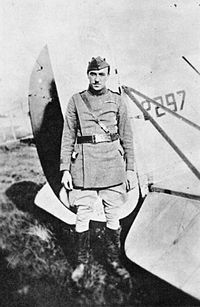Frank Goodden
| Frank Widenham Goodden | |
|---|---|

Goodden in RFC uniform
|
|
| Born |
3 October 1889 Pembroke, Pembrokeshire, Wales |
| Died | 28 January 1917 (aged 27) Farnborough, Hampshire, England |
| Buried at | Aldershot Military Cemetery, Hampshire, England (51°15′19″N 0°44′49″W / 51.25528°N 0.74694°WCoordinates: 51°15′19″N 0°44′49″W / 51.25528°N 0.74694°W) |
| Allegiance | United Kingdom |
| Service/branch | British Army |
| Years of service | 1915–1917 |
| Rank | Major |
| Battles/wars | World War I |
Major Frank Widenham Goodden (3 October 1889 – 28 January 1917) was a pioneering British aviator who served as chief test pilot for the Royal Aircraft Factory during the First World War.
Goodden was born in Pembroke, the second son of Harry Francis Goodden, a photographer from Eastbourne, and his wife, Emma Margaret Gould.
He left school aged 16 and worked in engineering for three years before joining the balloon manufacturing company C. G. Spencer and Sons in 1908. The following year he made his first balloon flight, before giving exhibition flights in towns across Britain. Goodden left Spencers in October 1910 to be the engineer for Ernest Willows in his Airship No. 3 "City of Cardiff" on a flight between London and Paris. The airship took off from Wormwood Scrubbs mid-afternoon on 4 November, taking three hours to reach the English coast and another two to cross the Channel. After night fell, cloud and fog meant they became lost over France, eventually setting down at Corbehem near Douai. Louis Breguet drove from his flying ground at La Brayelle nearby, to offer assistance in making repairs. Willows intended to continue the flight to the aerodrome at Issy in Paris the next day, but the weather deteriorated, and instead he packed up the airship and had it transported there by train. They stayed in Paris for a several weeks, celebrating the New Year by making several circuits around the Eiffel Tower.
Goodden returned to England in January 1911 and settled in Oxford, making several balloon flights and a number of parachute descents, before turning to heavier-than-air flying machines. Using a 35 h.p. J.A.P. engine recovered from a crashed aircraft he built his own monoplane in 1912, making several flights until lack of money obliged him to take a position as a flying instructor at the Caudron School at Hendon Aerodrome. He was granted Royal Aero Club Aviators' Certificate No. 506 on 3 June 1913 after soloing a Caudron bi-plane at the W. H. Ewen School at Hendon, where he then became an instructor, and was a regular participant in the popular air shows, demonstrations and races of the time.
...
Wikipedia
